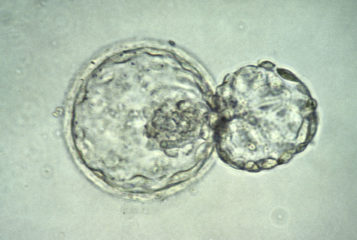The biological basis of a rare disorder has been clarified, thanks to stem cell technology. The researchers say their work shows how advances in stem cell science can provide insights into genetic conditions, especially those that are difficult to investigate as they arise during embryonic development.
LIG4 syndrome is a condition characterised by developmental delay, growth defects, reduced number of blood cells, increased predisposition to leukaemia, sensitivity to ionising radiation, and variable degrees of immunodeficiency. Patients will typically die in childhood.
The syndrome is so named because the fundamental defect is a mutation in the gene for DNA Ligase IV, an enzyme involved in repairing the most serious form of DNA damage — double strand breaks. Although the genetic defect in LIG4 is well established, the process by which DNA Ligase IV deficiency leads to the syndrome was previously unclear.
To investigate, researchers from the Institute of Genetic Medicine at Newcastle University and the Genome Damage and Stability Centre at the University of Sussex took advantage of one of the most important advances in biology over recent years - the ability to induce pluripotency in differentiated cells. In other words, it is now possible to turn specialised cells into recreations of the embryonic stem cells that gave rise to them.
For the study into LIG4 syndrome, the research team - led by Majlinda Lako, professor of stem cell science at Newcastle University - first collected skin cell samples from four patients. Induced pluripotent stem cells (iPSCs) were derived from these samples.
'The clinicians told us that it is difficult to study bone marrow cells in these children because they progressively lose bone marrow cells with age', says Professor Lako. 'So the question was: "What happens in the bone marrow of these children, especially in the womb, and can we mimic this with the iPSCs?"'
Using the expertise that Professor Lako had built up in her lab over the past five years, the team was able to coax the iPSCs to grow into blood cells. These cells appeared and survived in culture, but at a certain stage of development, suddenly perished. This indicated that patients are able to produce blood cells, but that those cells are defective due to the high incidence of uncorrected DNA damage.
Professor Lako adds: 'During development, our progenitor cells proliferate very fast. Millions and millions are needed to make up bone marrow. In LIG4 syndrome, blood progenitor cells appear to proliferate faster than normal. It is these fast proliferating cells that bear the most DNA damage. Due to an inability to repair this, they die at a faster rate, reducing the numbers of differentiated cells that make up our bone marrow.
'The higher proliferation of early progenitor cells with unrepaired DNA damage could also be one of the reasons why these children have a higher probability of developing leukaemia - this uncontrolled proliferation of defective cells'.
The research has implications for our understanding of embryonic development. DNA Ligase IV is an enzyme essential to a DNA double strand break repair process called non-homologous end joining. But it was another repair mechanism, called homologous recombination, that was thought to be most important in proliferating cells. This work challenges such assumptions.
The research serves as an early example of how stem cell research can clarify some of the underlying details of hard-to-manage disorders.
'The approach we're using can be applied to any congenital disease, provided the patients are able to donate a little bit of sample', says Professor Lako. 'We can take those cells and reprogram them. We can use them as a tool to study the underlying pathology, but also to research possibilities for genetic correction or drug screening. It really is a research approach that can be used in many different conditions'.
Professor Lako discussed her research prior to her presentation 'Using Human Pluripotent Stem Cells to Understand Our Beginnings and Treat Disease', given at the British Society for Human Genetics Annual Conference on Wednesday 19 September 2012 at the University of Warwick.
Sources and References
-
Home Page






Leave a Reply
You must be logged in to post a comment.